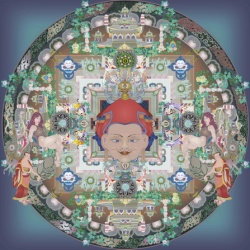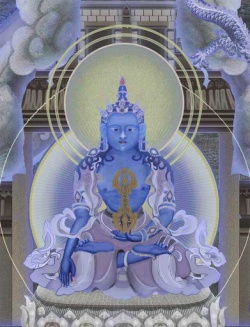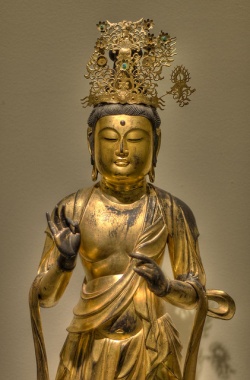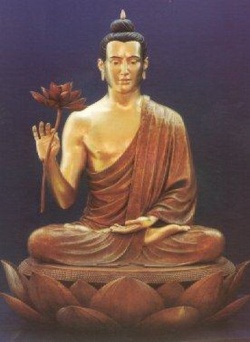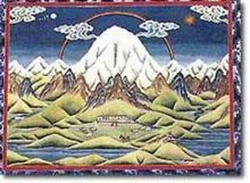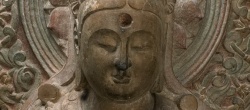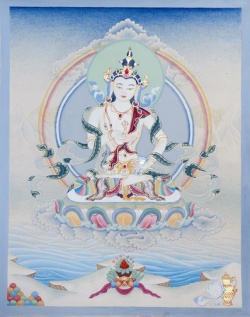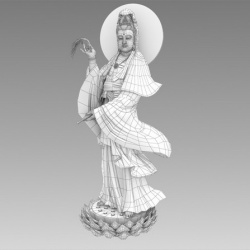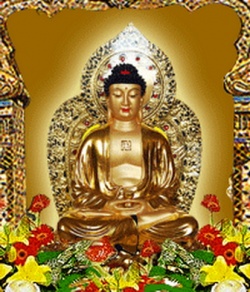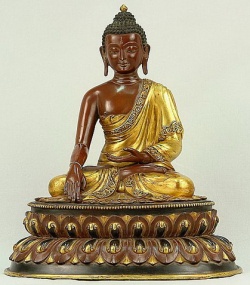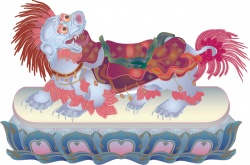The five-fold profound meanings
The unsurpassed, profound, and wonderful Dharma, Is difficult to encounter in hundreds of millions of eons, I now see and hear it, receive and uphold it, And I vow to fathom the Tathagata’s true meaning.
According to the instructions of the T’ien T’ai School, Sutras are outlined according to Five-fold Profound Meanings: Explaining the Name, Describing the Substance, Clarifying the Principle, Discussing the Function, and Determining the Teaching Mark. The Five-fold Meanings are called “five-fold” because they unfold, layer after layer.
Explaining the Name
The first is Explaining the Name. Only when you know the Sutra’s name can you begin to understand its principles. Just as when you meet a person you first learn his name, so it is with Sutras, for each has its own particular name. The titles of all Buddhist Sutras may be divided into two parts, the common title and the special title. The special title of this Sutra is the Buddha Speaks of Amitabha, and the word Sutra is the common title, as all discourses spoken by the Buddha are called Sutras.
Although five kinds of beings may speak Sutras,
1) The Buddhas,
2) The Buddha’s disciples,
3) Gods,
4) Immortals, and
5) Transformation beings, that is, gods or Buddhas who transform into human form.
The disciples, gods, immortals, and transformation beings must first receive the Buddha’s certification before they speak Sutra; without certification, what they speak is not truly a Sutra. This Sutra was spoken by the Buddha, not by those in the other four categories; it came from Shakyamuni Buddha’s mouth. Because its principles were too profound and wonderful for the Sravakas or Bodhisattvas to comprehend, no one requested the Pure Land Dharma-door. Nonetheless, it had to be revealed and so the Buddha spontaneously spoke this very important Sutra, doubly important because it will be the last to disappear in the Dharmaending age.
In the future, the Buddhadharma will become extinct. Demon Kings most fear the Shurangama mantra and so the Shurangama Sutra will be the first to disappear, for without the Sutra, no one will be able to recite the mantra. Then, one by one, the other Sutras will disappear. We now have the black words of the text on white paper, but in the future, when the Buddhadharma is on the verge of extinction, the words will disappear from the page, as all the Sutras vanish. The last to go will be the Amitabha Sutra. It will remain in the world an additional hundred years and ferry limitless living beings across the sea of suffering to the other shore, which is Nirvana. When the Amitabha Sutra has been forgotten, only the great phrase “Namo Amitabha Buddha” will remain among mankind and save limitless beings. Next, the word “Namo” which is Sanskrit and means “homage to” will be lost, and only “Amitabha Buddha” will remain for another hundred years, rescuing living beings. After that, the Buddhadharma will completely disappear from the world. Because this Sutra will be the last to disappear, it is extremely important.
Who is the Buddha? The Buddha is the Greatly Enlightened One. His great enlightenment is an awakening to all things, without a particle of confusion. A true Buddha has ended karma and transcended emotions. He is without karmic obstacles and devoid of emotional responses. On the other hand we find living beings, who are attached to emotions and worldly love. Common men with heavy karma and confused emotions are simply living beings. The Buddha’s enlightenment may be said to be of three kinds: 1) Basic enlightenment, enlightenment at the root source. 2) Beginning enlightenment, the initial stages of enlightenment, and
3) Ultimate enlightenment, complete enlightenment. You can also say that he is
1) Self-enlightened, that he
2) Enlightens others, and that he is
3) Complete in enlightenment and practice. Self-enlightenment. Common men are unenlightened. They think themselves intelligent when they are actually quite dull. They gamble thinking that they will win-who would have guessed that they’d lose? Why are they so confused? It’s because they do things which they clearly know are wrong. The more confused they are, the deeper they sink into confusion; the deeper they sink, the more confused they become.
Everyone should become enlightened. The Buddha is a part of all living beings and is one of them himself, but because he is enlightened instead of confused, he is said to be self-enlightened and not like common men. Sravakas, the disciples of the Small Vehicle, are “independents”; they are self-enlightened, but they do not enlighten others.
Bodhisattvas enlighten others, unlike the Sravakas who think only of themselves. Bodhisattvas choose to benefit all beings and ask for nothing in return. Using their own methods of self-enlightenment, they convert all beings causing them to realize the doctrine of enlightenment and non-confusion. This is the practice of the Bodhisattva conduct.
Sravakas, “sound-hearers”, awaken to the Way upon hearing the sound of the Buddha’s voice. They cultivate the Four Holy Truths,
1) Suffering,
2) Origination,
3) Extinction, and
4) The Way.
They also cultivate the Twelve Causes and Conditions: 1) Ignorance, which conditions…
2) Action, action which conditions…
3) Consciousness, consciousness which conditions… 4) Name and form, name and form which conditions… 5) The six sense organs, which condition… 6) Contact, contact which conditions…
7) Feeling, feeling which conditions…
8) Craving, craving which conditions…
9) Grasping, grasping which conditions…
10) Becoming, becoming which conditions… 11) Birth, and birth which conditions…
12) Old age and death.
The twelve all arise from ignorance, and ignorance is merely a lack of understanding. Without ignorance, the Twelve Causes and Conditions cease to operate. But if you flounder in ignorance, you are caught in the remaining causes. Those of the Small Vehicle cultivate the Dharma, but Bodhisattvas transcend all successive stages, cultivating the Six Perfections and the Ten-thousand conducts.
The Six Perfections are:
1) Giving. Giving transforms those who are stingy. Greedy people who can’t give should practice giving, for if they do not learn to give they will never get rid of their stinginess. 2) Morality. The precepts are guides to perfect conduct and eliminate offenses, transgressions, and evil deeds. Keep the precepts.
3) Patience. Patience transforms those who are hateful. If you have an unreasonable temper, cultivate being patient and bearing with things. Don’t be an asura, a fighter who gets angry all day and is not on speaking terms with anyone unless it’s to speak while glaring with fierce, angry eyes. Be patient instead. 4) Vigor. Vigor transforms those who are lazy. If you’re lazy, learn to be vigorous.
5) Dhyana meditation. Dhyana meditation transforms those who are scattered and confused.
6) Wisdom. Prajna wisdom transforms those who are stupid; the bright light of wisdom disperses the darkness of stupidity. Bodhisattvas cultivate the Six Perfections and the Ten-thousand conducts. Self-enlightened, they enlighten others, and are therefore unlike those of the Small Vehicle.
Complete Enlightenment. This is wonderful enlightenment, the enlightenment of the Buddha. The Buddha perfects self-enlightenment and the enlightenment of others, and when his enlightenment and practice are complete, he has realized Buddhahood. “You keep talking about the Buddha,” you say, “but I still don’t know who the Buddha is.”
You don’t know? I will tell you.
“You are the Buddha.”
“Then why don’t I know it?” you ask.
Your not knowing is just the Buddha! But this is not to say that you have already reached Buddhahood. You are as yet an unrealized Buddha. You should understand that the Buddha became a Buddha from the stage of a common person. It is just living beings who can cultivate to realize Buddhahood. The Buddha is the Enlightened One, and when a human being becomes enlightened, he’s a Buddha, too. Without enlightenment, he’s just a living being. This is a general explanation of the word Buddha. The Buddha has Three Bodies, Four Wisdoms, Five Eyes, and Six Spiritual Penetrations. You may be a Buddha, but you are still an unrealized Buddha, for you do not have these powers. The Buddha cultivated from the stage of a common person to Buddhahood, and has all the attributes of Buddhahood. Some who haven’t become Buddhas claim to be Buddhas. This is the height of stupidity; claiming to be what they are not, they cheat themselves and cheat others. Isn’t this to be a “Greatly Stupid One?” Everyone can become a Buddha, but cultivation is necessary. If one has the Three Bodies and the Four Wisdoms one may call oneself a Buddha. If one has just the Five Eyes, or a bit of spiritual penetration, one may not.
The Three Bodies are:
1) The Dharma body,
2) The Reward body,
3) The Transformation body.
The Four Wisdoms are:
1) The Great Perfect Mirror Wisdom,
2) The Wonderful Observing Wisdom,
3) The Wisdom of Accomplishing What is Done, and 4) The Equality Wisdom.
The Six Spiritual Penetrations are:
1) The Heavenly Eye.The Heavenly Eye can see the gods and watch all their activities.
2) The Heavenly Ear.The Heavenly Ear can hear the speech and sounds of the gods.
3) The Knowledge of Others’ Thoughts. Thoughts in the minds of others which they have not yet spoken are already known. This refers to the present. 4) The Knowledge of Past Lives. With this penetration one can also know the past.
5) The Extinction of Outflows. To be without outflows is to have no thoughts of greed, hate, stupidity, or sexual desire. In general, once one gets rid of all one’s bad habits and faults, one has no outflows. Outflows are like water running through a leaky bottle; at the stage of no outflows the leaks have been stopped up.
6) The Complete Spirit. Also called the Penetration of the Spiritual Realm, this is an inconceivably wonderful state. The Five Eyes are:
1) The Heavenly Eye,
2) The Buddha Eye,
3) The Wisdom Eye,
4) The Dharma Eye, and
5) The Flesh Eye.
A verse about the Five Eyes says,
The Heavenly Eye Penetrates without obstruction. The Flesh Eye sees obstacles but does not penetrate. The Dharma Eye only contemplates the mundane. The Wisdom Eye understands True Emptiness. The Buddha Eye shines like a thousand suns. Although the illuminations differ,
Their substance is one.
The Heavenly Eye penetrates without obstruction and sees the affairs of eighty-thousand great aeons. It cannot see beyond that. The Flesh Eye can see those things which are obstructed; the Heavenly Eye only sees those things which are not obstructed. The Dharma Eye contemplates the “mundane truth”, all the affairs of worldly existence. The Wisdom Eye comprehends the state of True Emptiness, the “genuine truth.”
Not just the Buddha, but everyone has a Buddha Eye. Some have opened their Buddha Eyes and some have not. The open Buddha Eye shines with the blazing intensity of a thousand suns. Although the Five Eyes differ in what they see, they are basically of the same substance.
So the Buddha has Three Bodies, Four Wisdoms, Five Eyes, and Six Spiritual Penetrations. If one has such talent, one may call oneself a Buddha, but if not, one would be better off being a good person instead of trying to cheat people. In this Sutra, Shakyamuni Buddha, the teacher of the Saha world, speaks of the adornments of the Land of Ultimate Bliss and of its teacher, Amitabha Buddha.
Saha is a Sanskrit term which mean “to be endured.”1 The world in which we live has so much suffering that living beings find it hard to endure, and so it is named Saha. Shakyamuni Buddha’s name, also Sanskrit, is explained in two parts. Sakya, his family name, means “able to be humane.”2 The Buddha shows his humaneness as compassion which rel ieves suffering, and kindness which bestows happiness by teaching and transforming living beings.
There are three kinds of compassion:
1) An Attitude of Loving Compassion. Average men love and sympathize with those close to them, but not with strangers. Seeing relatives or friends in distress, they exhaust their strength to help them, but when strangers are suffering, they pay them no heed. Having compassion for those you love is called an Attitude of Loving Compassion.
There is as well an Attitude of Loving Compassion which extends to those of the same species, but not to those of other species. For example, not only do people have no compassion for animals such as oxen, pigs, chickens, geese, or ducks, but they even go so far as to eat animals’ flesh! They snatch away animals’ lives in order to nourish their own. This is not a true Attitude of Loving Compassion. Fortunately, people rarely eat each other. They may eat pork, mutton, beef, chicken, duck, and fish, but they don’t catch, kill, and eat each other, and so they are a bit better off than animals that turn on members of their own species for food. People may not eat each other, but they certainly have no true Attitude of Loving Compassion towards animals.
2) Compassion which comes from understanding conditioned dharmas. Those of the Small Vehicle have compassion which comes from understanding conditioned dharmas as well as the attitude of loving compassion discussed above. They contemplate all dharmas as arising from causes and conditions and they know that:
Causes and conditions have no nature;
Their very substance is emptiness.
Contemplating the emptiness of conditioned dharmas, they compassionately teach and transform living beings without becoming attached to the teaching and transforming. They know that everything is empty.
3) The Great Compassion which comes from understanding the identical substance of all beings. Buddha and Bodhisattvas have yet another kind of compassion. The Buddha’s Dharma body pervades all places and so the Buddhas and Bodhisattvas are of one substance with all beings; the Buddha’s heart and nature are allpervasive and all beings are contained within it. We are living beings within the Buddha’s heart and he is the Buddha within our hearts. Our hearts and the Buddha’s are the same, everywhere throughout the ten directions, north, east, south, west, the directions in between, above, and below. Therefore the Buddha and living beings are of the same substance, without distinction. This is called the Great Compassion.
Sakya, the Buddha’s family name, includes these three kinds of compassion. If one chose to speak about it in more detail, there are limitless and unbounded meanings.
Muni is the Buddha’s personal name. It means “still and quiet.”3 Still and unmoving, he is silent. No words from the mouth, no thoughts from the mind-this is an inconceivable state. The Buddha speaks Dharma without speaking; he speaks and yet does not speak, does not speak and yet he speaks. This is still and silent, still, still, silent and unmoving, yet responding in accord; responding in accord and yet always, always silent and still. This is the meaning of the Buddha’s personal name, Muni. All Buddhas have the name Buddha in common, but only this Buddha has the special name Shakyamuni.
Continuing the explanation of the title, we shall now investigate the meaning of speak. In Chinese, the word speak shuo is made up of the radical yan which means “word,” and the element dui. Dui has two dots on the top which were originally the word ren, person. The strokes below could also represent the word person.
What does the Buddha say? Whatever he pleases, but happy to say what he wants to say, he always speaks the Dharma. Having already become Buddhas, Shakyamuni Buddha and the Buddhas of the ten directions are called “already enlightened ones,” as they have already understood and awakened from their dreams.
While we are still sound asleep and dreaming, the Buddha is greatly enlightened, greatly awakened. With his Buddha-wisdom there is nothing he does not know; using his Buddha-vision there is nothing he does not see. This is the meaning of his great enlightenment which came from cultivating, and this is the result to which he has certified. He has walked the road, he has been through it, he is an “already enlightened one.” The methods of cultivation he used to attain the fruit of enlightenment he then teaches, to lead all living beings to attain and certify to that ultimate, complete result of Bodhi. That is why he speaks the Dharma, and why, having done so, he is happy to have spoken.
What does he say?
Right now he speaks of Amitabha: the Buddha Speaks of Amitabha Sutra.
Amitabha, the next word in the title, is a Sanskrit word which means “limitless light.”4 Amitabha’s other name, Amitayus, means “limitless life.”5
“But,” you might ask, “the Sutra says that it has been ten kalpas since Amitabha realized Buddhahood. Ten kalpas is a definite length of time. Why do you speak of ‘limitless life’ and then measure it out in time?”
Amitayus, “limitless life,” refers to his blessings and virtue “Limitless light” refers to his wisdom. His wisdom light is limitless and bright. Limitless life, limitless light. Not only are his blessings, virtues, and wisdom limitless but so are his spiritual powers, his eloquence, his attributes, and his teachings. There is no way to count them because they are infinite, nowhere present and nowhere absent.
Where did the limitless come from? Mathematicians should know that the limitless comes from the one. One is many and many are one. A scholar once wrote a book and said, “Large numbers are written by starting with one and then employing many place holding zeros. Keep adding zeros until the space between heaven and earth is filled. When you have written all over your walls and covered your floors, can you determine the total? Couldn’t you still add another zero? Numbers are endless.”
Amitabha Buddha’s life, wisdom, merit, virtue, and Way-power are all infinite and unbounded. If you want a big figure, go ahead and write columns of zeros.
Knowing that there can be no definite total, the Buddha, who is the perfection of intelligence, just said, “Limitless and uncount- 4. wu liang guang , from the Sanskrit amita, “unmeasured” and abha, “splendor, light.”
5. wu liang shou , from the Sanskrit amita and ayus, “life-span, life.”
able.” Mathematics can explain infinity, and scientists have sent men into space to study it, but having arrived in empty space, there’s still more empty space beyond. There’s no end to it. Numbers go on infinitely and in this way we can understand the vast expanse of Amitabha Buddha’s blessedness, his virtue, and his wisdom. Therefore he is called Amita.
Both Amitabha and Shakyamuni Buddha were people who became Buddhas.
They did not descend from the heavens or ascend from the depths of the earth. As people they cultivated the Dharma and now they are sages, people who have realized the result. According to the classification of Sutra titles, this Sutra is established by reference to a person, but not a person like us. He is a Buddha, one who has realized the result. We are living beings; we have not realized the result, but are cultivating the cause of Buddhahood. Once Buddhahood is realized, we will be sages. This sage’s name, Amitabha, is used to classify the title of the Sutra. The Common Title A Sutra is called a “tallying text.”6 It tallies with the wonderful principles of all Buddhas above and with the opportunities for teaching living beings below. Each time I explain a Sutra, I add more meanings to the word. If I told you all of the meanings at once, you would never remember them, or if you did, the next time I spoke about it you would say, “I know all about it, a Sutra strings together, attracts, is permanent, and is a method. The Master certainly is repetitious.” So I explain the term “Sutra” bit by bit. In this commentary on The Amitabha Sutra I will discuss five of its meanings:
1) Basic Dharma. The Buddha reveals the origin of Dharma with his teaching by means of Four Kinds of Complete Giving: a) Mundane Complete Giving, using ordinary methods of expression,
b) Curative Complete Giving, curing each living being of his particular problem,
c) Complete Giving that is for everyone, teaching for the sake of all living beings.
d) The Complete Giving of the Primary Meaning, giving the highest principle to all beings.
Ultimately, the Dharma cannot be spoken because there is no Dharma to speak; but by practicing the Four Kinds of Complete Giving, the Buddha reveals it. Thus the word Sutra has the meaning of Basic Dharma.
2) Subtle Dharma. Unless the profound and wonderful doctrines are elucidated in the Sutras, no one can know of them. 3) Bubbling Spring. Principles flow from Sutras like gushing water from artesian wells.
4) Guideline. To make guidelines, ancient carpenters and stonemasons used a string covered with black ink, held the string taut, pulled it up, let it snap and made a straight, black line. A Sutra is also like a compass and square, used for guiding people. 5) A Garland. The principles are linked together in the Sutras like flowers woven into a garland.
The word Sutra also has four additional meanings: 1) Strings Together. Sutras string together the principles of the Buddhadharma.
2) Attracts. Sutras attract living beings who are in need of the teaching.
3) Method. The methods used in cultivation which have been employed from ancient times right up until the present are set forth in the Sutras.
4) Permanent. Sutras are permanent and unchanging; not one word can be left out or added to them, and heavenly demons and non-Buddhist religions cannot harm them. The word Sutra also means “a path.” If you wanted for example, to go to New York and didn’t know the way, you might run west instead of east. You could run all your life, but you would never get to New York. Cultivating is also like this. Unless you know the road, you may practice forever, but will never arrive at Buddhahood.
Sutras are also a canon, fixed documents to rely upon when cultivating according to Dharma. Sutras also explain worldly dharmas. You can find any doctrine you wish in the Sutras. Sutras are everyone’s breath; without them men are lost. We should step outside of our stuffy rooms to breathe the fresh air of the Sutras. People can’t live without air or Sutras. You ask, “I don’t study Sutras or the Dharma, so I don’t breathe that air, do I?”
Your breathe it, too, because the Dharma air fills the world, and whether or not you study it, you breathe it all the same. Everyone shares the air. Students of the Buddhadharma exhale Buddhadharma air and non-students breathe it in. You can’t avoid this relationship.
Sutras are also food for the spirit, and have many uses. When you’re melancholy or depressed, recite Sutras, for they explain the doctrines in a wonderful way, which dispels your gloom and opens your heart.
Sutra is the common name of all Sutra; this Sutra’s particular name is The Buddha Speaks of Amitabha . There are many Sutra names, because the Buddha left limitless unbounded Dharmajewels in the world; but of these hundreds and thousands of Sutras, none go beyond the Seven Classifications. The Seven Classifications of Sutra Titles In order to clarify their content, Sutra titles are divided into seven types by their reference to person, dharma, and analogy. 1) Single Three. Three of the seven titles are established by reference to either person, dharma, or analogy. a) The Buddha Speaks of Amitabha Sutra7 refers only to people. Shakyamuni Buddha and Amitabha Buddha are both people who cultivated and became Buddhas. b) The Great Parinirvana Sutra8 is an example of a title classified by reference to a dharma. Nirvana is the dharma of non-production and non-extinction.
c) The Net of Brahma Sutra9 is a title established only by reference to analogy, the analogy of the net of the Great Brahma King.
The net in the Brahma heaven has many holes in it, like a fish net, and there is a gem in every hole. Each gem radiates more brilliantly than an electric light, reflected through the interstices of the net. They interillumine, without conflict. One light, for example, would never say to another, “I hate your light, lamp. It’s terrible! I’m the only one who can shine around here.” Lamps don’t fight with each other like people. The net of Brahma is an analogy for the precepts. Each precept is like a gem, and those who have left home are one of the Three Jewels because they keep the precepts purely. Members of the Sangha cultivate to have no improper thoughts concerning their environment. Thus they transcend the material world, attain purity, and shine like gems in the net of Brahma.
7. fo shuo a mi tuo jing , Sukhavativyuha-sutra 8. da ban nie pan jing , Mahaparinirvana-sutra 9. fan wan jing , Brahmajala-sutra
2) Double Three. Titles established by reference to a combination of either person and dharma, person and analogy, or dharma and analogy are called “double three.” d) The Sutra of Questions of Manjushri10 is a title established by reference to a person, the greatly wise Bodhisattva Manjushri, and the Dharma he requested, Prajna. Only the most intelligent Bodhisattva knew to ask about the meaning of Prajna. One of great wisdom requesting the dharma of great wisdom classifies the Sutra title according to person and dharma.
e) The Lion Roar of the Thus Come One Sutra11 is a title established by reference to a person, the Thus Come One, and an analogy, the Lion Roar. The Buddha speaks Dharma like the lion roars, and when the King of Beasts roars, the wild beasts tremble. So, in his Song of Certifying to the Way, the Great Master Yung Chia Wrote, The roar of the lion is the fearless speaking; When the wild beasts hear it,
their heads split wide open.
Elephants run wild and lose their decorum, But gods and dragons, in silence,
hear it with delight.
The Buddha speaks the Dharma like the fearless lion roars. When the lion roars, the other animals are frozen with fright. Elephants are usually quite sedate, but they lose their powerful authoritarian stance. Gods, dragons, and the rest of the eight-fold division12, however, are delighted.
10. wen shu shi li wen jing , Manjusripariprccha-sutra 11. ? ji hou jing , Simhanadika-sutra
f) The Wonderful Dharma Lotus Blossom Sutra13 is an example of a title established by reference to a dharma and an analogy, since the wonderful Dharma is analogous to a lotus flower.
3) Complete in One. The seventh classification contains references to all three subjects: person, dharma, and analogy. g) The Great Means Expansive Buddha Flower Adornment Sutra14. In this Sutra, Great, Means, and Expansive refer to the wonderful Dharma of realizing Buddhahood; Flower Adornment is an analogy-the causal flowers of the ten thousand conducts are used to adorn the supreme virtue of the fruit.
The Twelve Divisions of Sutra Texts
In addition to the Seven Classifications of Sutra Titles, the texts comprising the entire Tripitaka, or Buddhist Canon, may be divided into twelve categories:
1) Prose lines.
2) Repetition of the meanings presented in the prose lines in short “verse lines” makes the text easy to remember. 3) Predictions of Buddhahood. Although future Buddhas have not yet realized Buddhahood, the present Buddha predicts their eventual accomplishment and gives them each a name. 12. The eight-fold division, or eight classes of supernatural beings are: gods, dragons, yaksa ghosts, gandharvas (musical spirits), kinnaras (also musical spirits), asuras (beings who like to fight), garudas (great-golden winged birds), and mahoragas (giant snakes).
13. miao fa lian hua jing , Saddharmapundarika-sutra 14. da fang guang fwo hua yan jing , Mahavaipulyabuddhavatamsaka- sutra
4) Interjections do not fit with the principles which come before or after them. They arise alone, like the short verses in the Vajra (Diamond) Sutra:
5) The Buddha Speaks of Amitabha Sutra belongs to the category of Sutras “spoken without request.” The Sound Hearer Disciples were not ready to understand the doctrines of the Pure Land Dharma-door, and the Bodhisattvas hadn’t conceived of this method or heard of Amitabha’s vow to save all beings. Everyone said that reciting the Buddha’s name was an old woman’s pastime and that those with wisdom did not need to study it. This is a serious mistake because unless you recite the Buddha’s name you continue to have useless scattered, lustful, desire-ridden thought. Reciting the Buddha’s name gets rid of discursive thought. One who recites the name all day long will have no discursive thought. The absence of such thought is wonderful. The wonderful dharma purges us of greed, hate, and stupidity. When I was seventeen I wrote a verse:
The King of all Dharmas is
the one word “Amitabha.”
The five periods and the eight teachings15 are all contained within it.
One who singlemindedly remembers
and recites his name.
Will enter into the still, and bright,
and unmoving field.
15. The Tian Tai School divides the Buddha’s teachings into five periods: the Avatamsaka, Agama, Vaipulya, Prajna, and Lotus-Nirvana. The teachings are also arranged in eight categories, four according to methods of teaching: sudden, gradual, secret, and unfixed, and four according tot he nature of the teaching: the storehouse teaching, the connecting teaching, the separate teaching, and the perfect teaching.
Reciting the Buddha’s name is much better than all of your crazy ideas!
This Sutra describes the practices leading to the Buddha’s Pure Land. Bodhisattvas didn’t ask for this dharma because they simply did not understand the subtle advantages of reciting the Buddha’s name. Since no one asked for this wonderful Dharma, Shakyamuni Buddha spoke without request.
6) Causes and conditions are also spoken by the Buddhas.
7) Analogies.
8) Past events discuss the events in the lives of the Buddha’s disciples.
9) Past lives discuss the events in the past lives of the Buddha.
10) Universal writings explain principle in an especially expansive way.
11) New Sutras are those which have never been spoken before.
12) Commentaries.
The essential message of this Sutra teaches us to recite the name “Namo Amitabha Buddha.” Amitabha Buddha has a great affinity with living beings of the Saha world. Before realizing Buddhahood, he made forty-eight vows and each one involved taking living beings to Buddhahood. At that time, he was a Bhikshu named Dharma Treasury. He said, “When I realize Buddhahood, I vow that living beings who recite my name will also realize Buddhahood. Otherwise, I won’t either.”
This is similar to the vow made by AvalokiteÇvara Bodhisattva in The Great Compassion Heart Dharani Sutra: “If anyone who recites this spiritual mantra does not obtain whatever he seeks, then this cannot be the Great Compassion Dharani.” By the power of his vows, Amitabha Buddha leads all beings to rebirth in his country where they realize Buddhahood. This power attracts living beings to the Land of Ultimate Bliss, just as a magnet The Buddha Speaks of Amitabha Sutra – The Five-fold Profound Meanings attracts iron filings. If living beings do not attain enlightenment, he himself won’t realize Buddhahood. Therefore, all who recite his name can realize Buddhahood.
The Dharma-door of reciting the Buddha’s name receives those of all three faculties and accepts both the intelligent and the stupid. People with wisdom have superior faculties, ordinary people have average faculties, and stupid people have inferior faculties. But whether one is intelligent, average, or stupid, if one recites the Buddha’s name one will definitely be born transformationally from a lotus in the Land of Ultimate Bliss. One will not pass through the womb but will enter a lotus flower, live in it for a while, and then realize Buddhahood. Whether you are stupid or wise, you can realize Buddhahood.
You say, “I don’t believe you can realize Buddhahood simply by reciting the Buddha’s name. It’s too easy. It’s like borrowing Amitabha’s power to realize Buddhahood.” You should not disbelieve this because a long time ago, Amitabha signed an agreement with us which said, “after I realize Buddhahood, you can recite my name and do so as well.” Since we signed our names, if we recite, we are sure to become Buddhas. Furthermore, reciting the Buddha’s name establishes a firm foundation and plants good roots. For example, there was once an old man who wanted to leave home. Although he was about seventy or eighty years old, couldn’t get around well, and was aware of his impending death, he thought he could easily leave home and be a High Master of Buddhism. When he arrived at the Garden of the Benefactor of Orphans and the Solitary, he found that Shakyamuni Buddha had gone out to receive offerings. His disciples, the Arhats, opened their heavenly eyes and took a look at this man’s past causes. Seeing that he hadn’t done a single good deed in the past eighty-thousand great aeons, they told him that he couldn’t leave home.
When he heard this, the old man’s heart turned cold and he ran, thinking, “If I can’t leave home, I’ll kill myself.” Just as he was about to throw himself into the ocean, Shakyamuni Buddha caught him and said, “What are you doing?”
“I wanted to leave home,” cried the man, “but the Buddha wasn’t at the Garden, and the great Bhikshus told me that I couldn’t because I have no good roots. My life is meaningless. I’m too old to work, and no one takes care of me. I might as well be dead.” Shakyamuni Buddha said, “Don’t throw yourself into the ocean. I’ll accept you.”
“You will?” said the man. “Who are you? Do you have the authority?”
Shakyamuni Buddha said, “I am the Buddha, and those Bhikshus are my disciples; none of them will object.” The old man wiped his eyes and blew his nose. “There’s hope for me,” he said.
The old man’s head was shaved. He became a monk and immediately certified to the first stage of Arhatship. Why? When he heard that he couldn’t leave home, he had decided to drown himself; although he didn’t really die, he was as good as dead. “I’ve already thrown myself into the sea,” he said, and relinquished all his attachment to life. He saw right through everything, won his independence, and certified to the first stage of Arhatship. This bothered the Bhikshus. “How strange,” they murmured, “the man has no good roots. We wouldn’t let him leave home, but the Buddha accepted him and now he’s certified to Arhatship. People without good roots can’t do that. Such a contradiction in the Teaching will never do! Let’s go ask the Buddha.” Then they went before the Buddha, bowed reverently, and asked, “We are basically clear-minded. How could that old man without good roots certify to Arhatship? How can the Buddhadharma be so inconsistent?”
Shakyamuni Buddha said, “As Arhats, you see only the events of the past eighty thousand aeons ago. More than eighty thousand aeons ago, the old man was a firewood gatherer. One day in the mountains he was attacked by a tiger and quickly climbed a tree. The tiger leaped and snapped his jaws, but missed. “This tiger, however, was smarter than the average tiger, ‘I’ll show you,’ it said. ‘I’ll chew through the trunk of the tree and when it falls I’ll eat you.’
“Now, if a mouse can gnaw through wood, how much the more so can a tiger. Tigers can make powder out of human bones. It chewed half way through the tree and terrified the old man whose life was hanging by a thread. Then he remembered, ‘In times of danger, people recite the Buddha’s name,’ and he called out, ‘Namo Buddha!’ which scared the tiger away and saved his life. After that, the old man forgot to recite, and so on this side of eighty thousand great aeons, he failed to plant good roots. However, the one cry of ‘Namo Buddha’ was the good seed which has now ripened and allowed him to leave home and certify to the fruit.”
